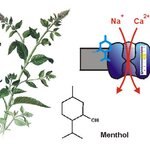Science & Society

Scientists have identified the receptor in cells of the peripheral nervous system that is most responsible for the body's ability to sense cold.
The findings reveal one of the key mechanisms by which the body detects temperature sensation. But in so doing it also illuminates a mechanism that mediates how the body experiences intense stimuli – temperature, in this case – that can cause pain.
Menthol and TRPM8
As such, the receptor – known as menthol receptor TRPM8 -- provides a target for studying acute and chronic pain, as can result from inflammatory or nerve injury, the researchers say,…

Too many weird stories to blog about today so here are some links:
Poland inquiry to probe 'gay' teletubbiesPoland's conservative government sees the teletubbies as homosexual propaganda on the small screen, and is taking aim at Tinky Winky and his friends. Ewa Sowinska, government-appointed children rights watchdog, told a local magazine published on Monday she was concerned the popular BBC children's show promoted homosexuality.
Bonnethead Sharks and Komodo Dragons reproduce without sexSex is not necessary for all members of the animal kingdom. Of course it has its advantages, primarily,…

Scientists in New Zealand have discovered that some cows have genes that give them the ability to produce skimmed milk naturally. They say they can use this information to breed herds of milkers producing only skimmed milk.
Even better, they said they can breed herds producing milk with the unique characteristics required to make a butter that is spreadable straight from the fridge.
They have already identified a cow, Marge, with the genes required to do this and say a commercial herd is likely by 2011. The milk is very low in saturated fats and so should be high in polyunsaturates and…

HIV treatment can be delivered even in settings of armed conflict, and humanitarian health agencies should not wait until a conflict is over before launching HIV care programs, say a team from Médecins Sans Frontières (MSF) in this week’s PLoS Medicine.
Heather Culbert and colleagues report their results of three years’ experience of providing HIV care, including antiretroviral therapy (ART), to a conflict-affected population in the Democratic Republic of the Congo (DRC). The reported treatment outcomes were similar to those in HIV projects in non-conflict settings.
"Our experience has shown…

Patterns of human behavior and movement in crowded cities – the tipping point at which agitated crowds become anti-social mobs, the configuration of civic areas as defensible spaces that also promote free speech, the design of retail space that fosters active walking – are at the core of an immersive 3-D computational model under development by an Arizona State University geographer.
"Crowds are vital to the lifeblood of our cities, yet, crowd behavior is veiled to traditional academic inquiry," says Paul M. Torrens, an assistant professor in the School of Geographical Sciences.
It is…

Now that the genome sequences of hundreds of bacteria and viruses are known, we can design tests that will rapidly detect the presence of these species based solely on their DNA. These tests can detect a pathogen in a complex mixture of organic material by recognizing short, distinguishing sequences—called DNA signatures—that occur in the pathogen and not in any other species.
Adam Phillippy and colleagues from the University of Maryland, USA, have developed a computer program that can identify these signatures with a higher degree of accuracy than ever before. They describe this new…

Scientists at the Universitat Autònoma de Barcelona (UAB), in cooperation with the CSIC, have developed a new electro-chemical biosensor which detects the presence, in food, of very small amounts of atrazine –one of the most widely used herbicides in agriculture and which also has very long lasting effects on the environment- as well as antibiotics in food.
The biosensor is faster, more portable and economic than the expensive laboratory methods which are used to detect contaminants, while having a very similar sensitivity. The system has been tested successfully to detect pesticides in…
Imagine being able to rapidly identify tiny biological molecules such as DNA and toxins using less than a drop of salt water in a system that can fit on a microchip.
In a paper appearing next week in the Proceedings of the National Academy of Sciences,* the team proves for the first time that a single nanometer-scale pore in a thin membrane can be used to accurately detect and sort different-sized polymer chains (a model for biomolecules) that pass through or block the channel.
Graphic showing a lipid bilayer membrane (blue) with an alpha-hemolysin nanopore. A polyethylene glycol molecule (…
Researchers at the University of Illinois have developed a simple and economical technique for imaging and mapping fruit fly chromosomes. This new approach will enable them to construct the first accurate map of the chromosomes and tease out the secrets hidden in their stripes.
Developers of the new approach use a technology called Computer Vision to analyze hundreds of crisp images of the same chromosomes. This will allow the production of a much more precise map of the chromosome bands. Credit: Photo courtesy of Dmitri Novikov
Fruit flies are well suited for chromosome studies because…

Solar powered mobility scooters could soon be on the streets thanks to the work of a student at The University of Nottingham. Matt Alvey, who is studying Architecture and Environmental Design, says the photovoltaic (solar electric) recharging system will turn the mobility vehicles truly green.
The project began when a company that manufactures secure storage sheds for the scooters approached the university about integrating solar power to recharge the vehicle. If Matt can find a solution it will overcome problems often associated with connecting mains power to the shed. This can prove costly…